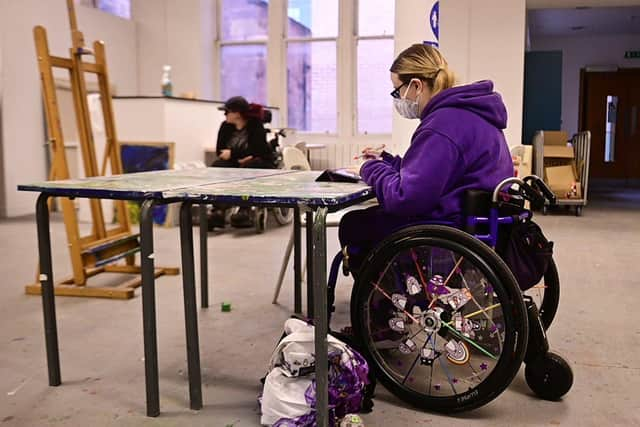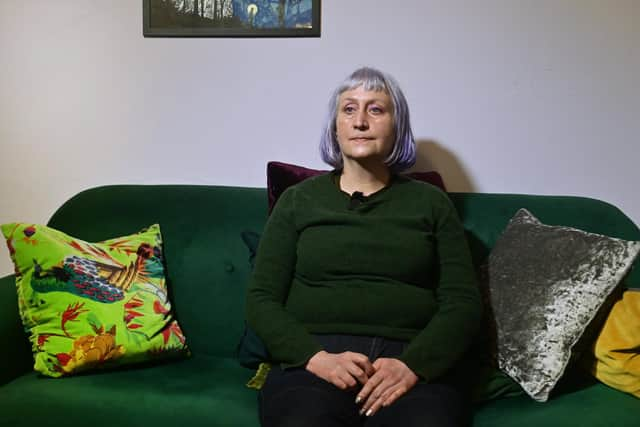Scottish disabled artists condemn access barriers ahead of Glasgow International arts festival
Disabled artists have called on venues, curators, and funding bodies in Scotland’s visual arts sector to make widespread improvements around access and representation, with several practitioners warning of a lack of understanding of the barriers facing artists and audiences at cultural spaces.
A new documentary, filmed and produced by The Scotsman and Scotland on Sunday’s John Devlin, reveals how some physically disabled artists have been unable to attend venues due to a lack of disabled access, and left feeling “unwelcome” due to the restrictions in place. They have questioned whether organisations unable to stage accessible exhibitions should continue to receive public funding, and warned the knock-on effect of a lack of representation could discourage young disabled Scots from pursuing a career in the arts.
Advertisement
Hide AdAdvertisement
Hide AdThe issues around accessibility and representation have flared up ahead of the coming Glasgow International festival of contemporary art. The programme for the prestigious biennial event includes an exhibition at the Celine Gallery, located on the the third floor of a tenement building in the city’s southside, accessible only by three flights of stairs. One artist, Penny Anderson, described that decision as “wrong”.
The Glasgow-based artist and sculptor, who has multiple sclerosis, said it was unclear who, if anyone, was responsible for ensuring such exhibitions were accessible, and was left frustrated after raising the issue with councillors in the city and Creative Scotland.
Under the Equality Act 2010, art galleries are required to make “reasonable adjustments”, if asked, to ensure that disabled people can use its services. Ms Anderson said the legislation should be followed by Glasgow International. “They have to make reasonable adjustments to allow inclusion and I think a reasonable adjustment is only including accessible galleries,” she said.
Ms Anderson said the accessibility issues went beyond any one gallery, and claimed there was a widespread lack of knowledge across the sector about how to include disabled artists and visitors. “They don’t understand the different levels of mobility impairment of physical disability,” she said. “I’ve had people say ‘but we’ve got a ramp’. Ramps make my life even harder. What I need is stairs and a handrail. Even if you have a ramp, wheelchairs might not be able to use the ramp, and I think people think they know, and just assume they know, but they don’t actually ask disabled people.”
Ruth Mutch, an illustrator who is autistic and has Hypermobile Ehlers-Danlos syndrome – a condition that affects the joints, causing hypermobility, digestive problems, joint pain and extreme fatigue – echoed Ms Anderson’s concerns, recounting her experience at college where she was unable to access materials without assistance.


“A lot of places are either totally accessible or [say] they’re accessible, but spend 20 minutes hunting for the ramp,” she said. “You kind of feel like you’re not really welcome sometimes, it’s like you’re too much hassle.
“Organisations like Glasgow Disability Alliance do mystery visits to galleries and museums to see what’s working and what’s not. But I’ve done one of these visits myself and I’ve never seen any actually being made. So what’s the point in these visits if nothing is actually implemented or altered after them?
Katrina Brown, the director of Common Guild, a Glasgow-based visual arts organisation, said it had embarked on its own accessibility journey. It was previously based in a grand Victorian townhouse where access issues could not be solved by adaptation. The answer was to move to a temporary space with step-free access from street level.
Advertisement
Hide AdAdvertisement
Hide AdMs Brown said: “I don’t think it is good enough now to think that it’s OK for there to be physical barriers for people to publicly funded culture. I think we all need to embrace the fact that we’re a diverse populace and we should all be able to get equal access to equally high quality culture when we want it ... this is something that artists I know who have physical disabilities are always saying, that until we see ourselves in programmes, buildings, organisations, it’s very difficult for some people – not for everyone – to imagine that that’s a path for them."


Asked about the criticisms made by Ms Anderson, Richard Birkett, the director of Glasgow International, pointed out that a significant part of the city’s built environment predated the 20th century. He said the festival was “rooted” in the history of “artist-led organising” ,with venues such as flats, and temporary spaces that are vacant. He explained: “There are particular spaces in the city for which part of the identity of what they do, part of the way in which they work, is tied to the physical space.”
However, Mr Birkett said there were questions for the sector as a whole to address in terms of ensuring disabled artists were represented. “What are the barriers that are in place to people working as artists, presenting their work as artists, and being involved in organising around art as well,” he said.
“I think awareness has improved a lot in the time that I’ve been working in the art industry. The conversation has been a lot more widespread around disability justice and the cultural sector. I think the kind of changes that need to be made are moving too slow, I think that’s very clear, as they are in society in general.”
Creative Scotland was unable to provide anyone for interview for the film. But in a statement, the organisation said it aimed to put equalities and diversity “at the heart of all our activity”, enabling people from different backgrounds, diverse communities, and all ages to access increased opportunity through access to arts and culture. The statement said Creative Scotland provided support to the disabled arts commissioner, Unlimited, which awarded 15 new artistic commissions in March, with each of the projects receiving between £15,000 and £80,000 to create new work.
The Celine Gallery did not respond to enquiries.
Comments
Want to join the conversation? Please or to comment on this article.